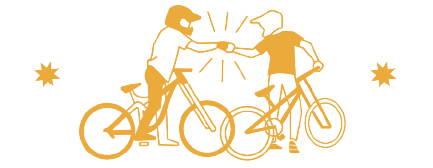Think dropping your outside foot is always right? The surprising truth about cornering and the technique that could transform your riding.
How to Corner Smarter: Drop the Foot or Stay Level?
One of the most common questions I hear on the trail — and honestly, one of the most debated — is: “Should I drop my outside foot when cornering on a mountain bike?”
It sounds straightforward, but the answer isn’t a simple yes or no. It depends. It depends on the trail, the speed, the type of turn, and, most importantly, how you’re moving the rest of your body. In this post, I’m going to walk you through my process for figuring that out mid-ride.
I call the system Tip and Twist. It’s not just about foot position — that’s only one part of the puzzle. Tip and Twist combines three connected elements:
Angulation – tipping the bike, not your body, into the turn.
Rotation – twisting your hips and torso toward the exit.
Inclination – letting your bike and body lean together as needed.
No matter which combination you use, the base rule stays the same: keep your body centred over the bike. Whether you’re tall and relaxed or low and aggressive, your chin should be over the stem. That central position is the anchor for everything else.
Putting It to the Test
I wanted to make sure I wasn’t just relying on theory, so I set up a test corner: mellow approach, 90-degree turn, low friction, and plenty of space to move. I marked it with cones and ran three separate trials, each with a different pedal strategy.
Trial 1 – Pedals Level
I stayed tall before the corner, lowered slightly on entry, and kept my pedals level the whole way through. It felt stable enough, but the bike was stiff. There wasn’t much room to let it tip underneath me, so the carve was limited. At higher speeds, I could feel the risk of the tyres letting go.
Pedals level
Trial 2 – Full Outside Foot Drop from the Start
This time, I went in with the outside foot fully dropped before I even began to lean. The initial grip was strong, but I overshot the exit. The reason? Dropping too early actually restricted my bike lean. My body position locked me out of proper angulation, forcing a wider, sloppier turn.
Outside foot fully dropped
Trial 3 – Adaptive Foot Drop
For the last run, I leaned the bike first (Tip) and rotated my hips toward the exit (Twist). My outside foot only dropped when the bike needed more room to lean. It was a by-product of the main movement, not the starting point. The result was completely different — smooth, tight, stable, and fast.
Foot dropping as and when needed to accommodate the bike lean and hip twist
The Takeaway
Dropping your outside foot isn’t wrong. But it’s a tool, not a rule. If you start with it before you’ve even leaned the bike or rotated your hips, you can shut down the very movements that create traction in a corner and keep it fast and smooth. The foot drop should complement your Tip and Twist, not replace it.
A great way to feel this for yourself is with a simple drill:
Ride a marked corner with pedals level.
Ride it again with a full outside foot drop from the start.
Then ride it using Tip and Twist, letting the foot drop happen naturally as you lean and rotate.
Film each attempt if you can. You’ll be surprised how much difference timing makes.
💬 What I learned:
After testing all three approaches, this was my takeaway:
"Using my outside foot as an adaptive tool to accommodate the movement of tip and twist gave me the best control. I could lean the bike in as needed, stay planted, and exit clean." It’s not about always dropping the foot, or never doing it. It’s about learning when, why, and how much to drop — based on your speed, line, and overall traction.
FAQs: MTB Cornering & Foot Drop
Q: How do I know if I dropped too much?
A: If your bike over-leans and drifts wide, you likely dropped too far, too early. Focus on staying dynamic — drop with the turn, not before it.
Want to Corner Like a Pro?
Join a cornering-specific coaching session with Treadmark in Queenstown. We’ll help you break down your riding technique, build smooth transitions, and get more confident in every type of turn — berms, flat corners, off-cambers, and more.
📆 Book your private or group session here:
📧 Have questions? Contact us at management@treadmark.co.nz



